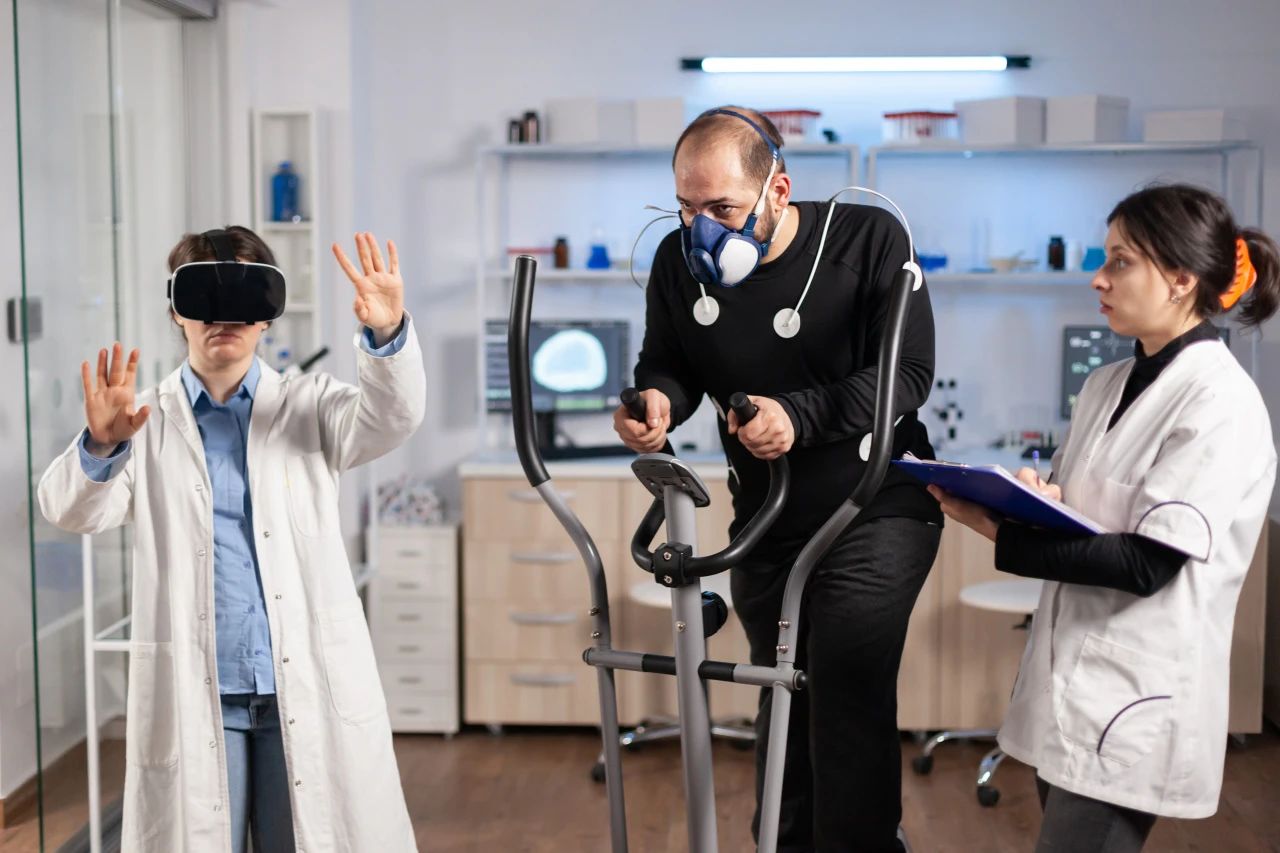
Introduction: The Intersection of AI and Sports Medicine
Sports medicine, focused on the diagnosis, treatment, and prevention of injuries in athletes and physically active individuals, is undergoing a transformative shift with the integration of artificial intelligence (AI). Technologies such as machine learning, computer vision, and natural language processing are reshaping how clinicians and coaches monitor performance, predict injuries, and personalize rehabilitation protocols.1 These innovations span from elite-level sports to general physical rehabilitation, offering data-driven insights previously unattainable through traditional methods.
AI is now playing a central role in several domains: real-time biomechanical and physiological data analysis for performance optimization, predictive modeling for injury prevention, enhanced diagnostic accuracy using imaging and motion analysis, and personalized rehabilitation based on continuous monitoring and adaptive feedback.2 Frontier technologies—such as AI-integrated wearables and interactive digital coaching platforms—are further empowering clinicians and athletes by delivering real-time, actionable insights. As these tools evolve, AI is poised to redefine athlete care, enabling safer, more efficient, and more individualized sports medicine.3,4
AI in Performance Monitoring and Enhancement
AI has significantly advanced performance monitoring by utilizing wearable sensors and computer vision systems to assess real-time biomechanical data, including gait patterns, joint angles, and ground reaction forces. These insights help identify inefficiencies in techniques such as sprinting or throwing and provide precise, actionable feedback to coaches and athletes.5
Beyond biomechanics, AI integrates physiological metrics—heart rate variability, sleep quality, training load—to build predictive models that forecast fatigue, identify optimal performance windows, and reduce the risk of overtraining. This allows for tailored athlete management strategies.6
In practice, sport-specific AI applications are increasingly adopted. Basketball players benefit from AI monitoring of jump mechanics and shooting form, while GPS-based AI systems in soccer track movement and workload to inform game strategy and reduce injury risk. These tools translate vast datasets into targeted interventions that improve training precision and athletic outcomes. Nonetheless, the success of AI implementation depends on collaboration between data scientists and sports professionals, as well as the development of context-specific algorithms that account for sport-specific demands and environments.7,8
Injury Prediction and Prevention
AI is redefining injury prevention by shifting the focus from reactive to proactive care. Machine learning models trained on extensive datasets—including movement biomechanics, training history, and physiological variables—can identify patterns predictive of injury. For example, studies have shown high accuracy in forecasting anterior cruciate ligament (ACL) injuries in soccer players and stress fractures in endurance athletes.9
AI-driven workload monitoring tools evaluate metrics such as the acute-to-chronic workload ratio, helping balance training stress and recovery to prevent overuse injuries. Screening tools powered by AI assess balance, mobility, and asymmetry to detect neuromuscular deficiencies that may predispose athletes to injury, supporting early intervention strategies.9,10
Real-time feedback through AI-integrated wearables enhances training safety by allowing dynamic adjustments to load and technique. While challenges around data quality, algorithm transparency, and ethical use remain, the potential of AI to reduce injury incidence and associated healthcare costs is substantial—particularly in team sports and high-performance environments.12,13
Rehabilitation and Recovery Optimization
AI technologies are also revolutionizing rehabilitation by enabling more personalized, efficient, and accessible recovery pathways. Intelligent physiotherapy platforms—leveraging motion tracking and computer vision—guide athletes through home-based exercises, providing real-time feedback on form and adherence.14 These systems improve consistency and engagement outside clinical settings.
Machine learning algorithms further personalize rehabilitation by dynamically adjusting intensity and duration based on real-time patient data such as mobility progress, biometric metrics, and self-reported pain scores. This adaptability supports optimal healing while reducing the risk of re-injury.15
Immersive technologies like augmented reality (AR) and virtual reality (VR) are being integrated into AI-driven rehab protocols, offering interactive, gamified experiences that enhance neuromuscular re-education and motivation. These platforms are particularly valuable in reaching remote or underserved populations where access to traditional rehab services may be limited.16
As AI applications in sports rehabilitation continue to advance, they promise to improve clinical outcomes, enhance patient engagement, and streamline recovery—ultimately supporting a faster and safer return to play.
Reference:
Sports Medicine Update. The AI Revolution is Already Here: Transforming Orthopedics in 2024 and Beyond. AOSSM. 2024 Sep 13.
Speranza G, et al. Value of clinical review for AI-guided deep vein thrombosis diagnosis with ultrasound imaging by non-expert operators. Nat Digit Med. 2025; [PMCID: PMC12031111].
Bolek M, Musialska D, Kędzia A, et al. The Application of Artificial Intelligence in Medical Diagnostics: Implications for Sports Medicine. Quality in Sport. 2025;41:60392. DOI:10.12775/QS.2025.41.60392
Esska Journals. Artificial Intelligence Applications in the Management of Sports Injuries. 2025 Apr 28.
Hristovski R, et al. Empowering the Sports Scientist with Artificial Intelligence in Team Sports. Sensors (Basel). 2024 Dec 29; [PMC11723022].
Alomar M, et al. The Role of Artificial Intelligence in Enhancing Sports Education and Performance. Front Sports Act Living. 2024 Apr 18; [PMC12075118].
Speranza G, et al. Value of Clinical Review for AI-Guided Deep Vein Thrombosis Diagnosis with Ultrasound Imaging by Non-Expert Operators. Nat Digit Med. 2025 May 5.
García-Aliaga A, et al. Performance and Healthcare Analysis in Elite Sports Teams Using Artificial Intelligence. Front Sports Act Living. 2024 Apr 18.
A Comprehensive Review of Injury Risk Prediction Methods. Front Sports Act Living. 2024 Nov 10; [PMID: 39594182].
Empowering the Sports Scientist with Artificial Intelligence in Injury Prevention. Front Sports Act Living. 2024 Dec 29; [PMCID: PMC11723022].
Diagnostic Applications of AI in Sports: A Comprehensive Review. Diagnostics (Basel). 2024 Nov 22;14(22):2516.
Performance and healthcare analysis in elite sports teams using AI. Front Sports Act Living.2024 Apr 18; [PMCID: PMC1383723].
Wearable AI systems for real-time injury prevention and recovery optimization. Sensors (Basel).2024;24(3):789.
The role of artificial intelligence in enhancing sports education and rehabilitation. Front Public Health. 2025 Apr 30; [PMC12075118].
Empowering the sports scientist with AI: training load management and injury prevention. Sensors (Basel). 2024 Dec 29; [PMC11723022].
Application of AI and virtual reality technology in rehabilitation training of athletes. Comput Intell Neurosci. 2022 Aug; [DOI:10.1155/2022/9828199].







Post comments